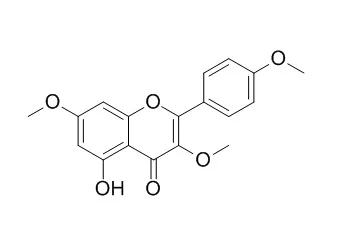| In vitro: |
| BMC Complement Altern Med. 2014 Sep 19;14:340. | | Cytotoxicity of four Aframomum species (A. arundinaceum, A. alboviolaceum, A. kayserianum and A. polyanthum) towards multi-factorial drug resistant cancer cell lines.[Pubmed: 25239700 ] | The search for natural products as potential cytotoxic agents has yielded promising candidates. However multidrug resistance (MDR) is still a major hurdle for patients receiving chemotherapy. In the present study, we evaluated the cytotoxicity of the methanol extracts of four dietary Aframomum plant species (A. arundinaceum, A. alboviolaceum, A. kayserianum and A. polyanthum) against nine sensitive and MDR cancer cell lines. We have also identified the bioactive constituents of A. arundinaceum.
METHODS AND RESULTS:
The cytotoxicity of the methanol extracts of the above plants was determined using a resazurin reduction assay. Chromatographic techniques were used to isolate the constituents of A. arundinaceum.
A preliminary experiment on leukemia CCRF-CEM cells at 40 μg/mL showed that the extracts from A. kayserianum and A. alboviolaceum as well as the isolated compounds namely compounds aframodial (1), 8(17),12-labdadien-15,16-dial (2), galanolactone (3), 1-p-menthene-3,6-diol (6) and 1,4-dimethoxybenzene (7) were less active, inducing more than 50% growth of this cell line contrary to A. polyanthum and A. arundinaceum extracts, galanals A (4) and B (5), naringenin (8) and Kaempferol 3,7,4'-trimethylether (9). The IC50 values below or around 30 μg/mL were recorded with A. arundinaceum extract against eight of the nine tested cancer cell lines. This extract as well as compound 8 displayed IC50 values below 40 μg/mL towards the nine tested cancer cell lines whilst A. polyanthum extract, compounds 4, 5 and 9 showed selective activities. Collateral sensitivity (hypersensitivity) was observed with A. arundinaceum extract towards leukemia CEM/ADR5000 cells and glioblastoma U87MG.ΔEGFR compared to their respective sensitive counterparts CEM/CEM and U87MG.
CONCLUSIONS:
The results of this study provide evidence of the cytotoxicity selected Aframomum species as well as a baseline information for the potential use of Aframomum arundinaceum in the fight against drug sensitive and otherwise drug-resistant cancers. | | Songklanakarin Journal of Science and Technology, 2013, 35,(3): 317-23. | | Inhibition of nitric oxide production by compounds from Boesenbergia longiflora using lipopolysaccharide-stimulated RAW264.7 macrophage cells[Reference: WebLink] |
METHODS AND RESULTS:
The inhibitory activity of extract and compounds isolated from Boesenbergia longiflora against nitric oxide (NO) was evaluated using RAW264.7 cells. Isolation of the chloroform extract of B. longiflora rhizomes afforded four known flavonoids, which were identified as Kaempferol 3,7,4'-trimethylether (1), kaempferol-7,4'-dimethyl ether (2), rhamnazin (3), pinostrobin (4), together with four known diarylheptanoids, dihydrobisdemethoxycurcumin (5), curcumin (6), demethoxycurcumin (7) and bisdemethoxycurcumin (8), as well as one sterol, -sitosterol-D-glucoside (9). Compound 6 exhibited the highest inhibitory activity against NO release with an IC50 value of 4.5 μM, followed by 7 (IC50 = 11.7 μM), 8 (IC50 = 15.7 μM), 5 (IC50 = 23.0 μM) and 1 (IC50 = 23.5 μM), respectively.
CONCLUSIONS:
This study demonstrated that diarylheptanoids and some methoxyflavonoids found in B. longiflora are responsible for anti-inflammatory activity and this is the first report the safety, chemical constituents and biological activity of this plant. |
|






 Cell. 2018 Jan 11;172(1-2):249-261.e12. doi: 10.1016/j.cell.2017.12.019.IF=36.216(2019)
Cell. 2018 Jan 11;172(1-2):249-261.e12. doi: 10.1016/j.cell.2017.12.019.IF=36.216(2019) Cell Metab. 2020 Mar 3;31(3):534-548.e5. doi: 10.1016/j.cmet.2020.01.002.IF=22.415(2019)
Cell Metab. 2020 Mar 3;31(3):534-548.e5. doi: 10.1016/j.cmet.2020.01.002.IF=22.415(2019) Mol Cell. 2017 Nov 16;68(4):673-685.e6. doi: 10.1016/j.molcel.2017.10.022.IF=14.548(2019)
Mol Cell. 2017 Nov 16;68(4):673-685.e6. doi: 10.1016/j.molcel.2017.10.022.IF=14.548(2019)